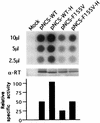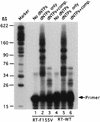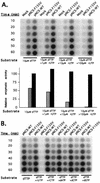Replication defect of moloney murine leukemia virus with a mutant reverse transcriptase that can incorporate ribonucleotides and deoxyribonucleotides
- PMID: 9621052
- PMCID: PMC110394
- DOI: 10.1128/JVI.72.7.5905-5911.1998
Replication defect of moloney murine leukemia virus with a mutant reverse transcriptase that can incorporate ribonucleotides and deoxyribonucleotides
Abstract
Reverse transcriptase (RT) plays a critical role in retrovirus replication, directing the synthesis of a double- stranded DNA copy of the viral RNA genome. We have previously described a mutant RT of the Moloney murine leukemia virus in which F155 was replaced by valine, and we demonstrated that this substitution allowed the enzyme to incorporate ribonucleotides to form RNA while still retaining its normal ability to incorporate deoxyribonucleotides to form DNA. When introduced into the viral genome, this mutation rendered the virus incapable of replication. Characterization of the mutant virus revealed that the enzyme was still active and able to synthesize minus-strand strong stop DNA and some longer products but failed to make full-length minus-strand DNA. We propose that the failure of the enzyme to complete DNA synthesis in vivo resulted from its ability to incorporate ribonucleotides into the products, which served as inhibitors for DNA synthesis. We also tested seven other amino acid residues for their abilities to substitute for F155 in virus replication; of these, only tyrosine could support virus replication. In an attempt to select for second-site suppressor mutations, the F155V mutant was subjected to random mutagenesis and was used as a parent for the isolation of revertant viruses. Two independent revertants were found to have changed the valine residue at position 155 back to the wild- type phenylalanine. These results suggest that an aromatic ring at this position is important for virus replication.
Figures









Similar articles
-
Gln(84) of moloney murine leukemia virus reverse transcriptase regulates the incorporation rates of ribonucleotides and deoxyribonucleotides.FEBS Lett. 2006 Feb 20;580(5):1497-501. doi: 10.1016/j.febslet.2006.01.044. Epub 2006 Jan 25. FEBS Lett. 2006. PMID: 16466720
-
Mutations of the RNase H C helix of the Moloney murine leukemia virus reverse transcriptase reveal defects in polypurine tract recognition.J Virol. 2002 Aug;76(16):8360-73. doi: 10.1128/jvi.76.16.8360-8373.2002. J Virol. 2002. PMID: 12134040 Free PMC article.
-
Effects on DNA synthesis and translocation caused by mutations in the RNase H domain of Moloney murine leukemia virus reverse transcriptase.J Virol. 1995 Jul;69(7):4440-52. doi: 10.1128/JVI.69.7.4440-4452.1995. J Virol. 1995. PMID: 7539510 Free PMC article.
-
[The presence of ribonucleotides in DNA has an ambiguous impact on the maintenance of genetic stability].Postepy Biochem. 2019 Jun 6;65(2):143-152. doi: 10.18388/pb.2019_247. Postepy Biochem. 2019. PMID: 31642653 Review. Polish.
-
From deoxynucleotides to DNA synthesis.Fed Proc. 1978 Jan;37(1):9-14. Fed Proc. 1978. PMID: 201504 Review.
Cited by
-
Mutations in HIV-1 reverse transcriptase affect the errors made in a single cycle of viral replication.J Virol. 2014 Jul;88(13):7589-601. doi: 10.1128/JVI.00302-14. Epub 2014 Apr 23. J Virol. 2014. PMID: 24760888 Free PMC article.
-
Role of murine leukemia virus reverse transcriptase deoxyribonucleoside triphosphate-binding site in retroviral replication and in vivo fidelity.J Virol. 2000 Nov;74(22):10349-58. doi: 10.1128/jvi.74.22.10349-10358.2000. J Virol. 2000. PMID: 11044079 Free PMC article.
-
Mutations proximal to the minor groove-binding track of human immunodeficiency virus type 1 reverse transcriptase differentially affect utilization of RNA versus DNA as template.J Virol. 2003 May;77(10):5837-45. doi: 10.1128/jvi.77.10.5837-5845.2003. J Virol. 2003. PMID: 12719577 Free PMC article.
-
A mouse model for study of systemic HIV-1 infection, antiviral immune responses, and neuroinvasiveness.Proc Natl Acad Sci U S A. 2005 Mar 8;102(10):3760-5. doi: 10.1073/pnas.0500649102. Epub 2005 Feb 23. Proc Natl Acad Sci U S A. 2005. PMID: 15728729 Free PMC article.
-
dNTP versus NTP discrimination by phenylalanine 451 in duck hepatitis B virus P protein indicates a common structure of the dNTP-binding pocket with other reverse transcriptases.Nucleic Acids Res. 2002 Apr 1;30(7):1679-87. doi: 10.1093/nar/30.7.1679. Nucleic Acids Res. 2002. PMID: 11917030 Free PMC article.
References
Publication types
MeSH terms
Substances
Grants and funding
LinkOut - more resources
Full Text Sources
Other Literature Sources

